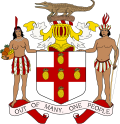Portal:Jamaica
The Jamaica Portal
Jamaica is an island country in the Caribbean Sea and the West Indies. At 10,990 square kilometres (4,240 sq mi), it is the third-largest island—after Cuba and Hispaniola—of the Greater Antilles and the Caribbean. Jamaica lies about 145 km (78 nmi) south of Cuba, 191 km (103 nmi) west of Hispaniola (the island containing Haiti and the Dominican Republic), and 215 km (116 nmi) southeast of the Cayman Islands (a British Overseas Territory). With 2.8 million people,0 Jamaica is the third most populous Anglophone country in the Americas and the fourth most populous country in the Caribbean. Kingston is the country's capital and largest city. Jamaica is a parliamentary constitutional monarchy, with power vested in the bicameral Parliament of Jamaica, consisting of an appointed Senate and a directly elected House of Representatives. Andrew Holness has served as Prime Minister of Jamaica since March 2016. Jamaica is a Commonwealth realm, with Charles III as its king; the appointed representative of the Crown is the Governor-General of Jamaica, the office having been held by Patrick Allen since 2009. Because of a high rate of emigration for work since the 1960s, there is a large Jamaican diaspora, particularly in Canada, the United Kingdom, and the United States. Most Jamaicans are of Sub-Saharan African ancestry, with significant European, East Asian (primarily Chinese), Indian, Lebanese, and mixed-race minorities. (Full article...) Selected article -Kingston Harbour in Jamaica is the seventh-largest natural harbour in the world. It is an almost landlocked area of water approximately 16 kilometres (9.9 mi) long by 3.2 kilometres (2.0 mi) wide. Most of it is deep enough to accommodate large ships, even close to shore. It is bordered to the north by the city of Kingston, the capital of Jamaica; to the west by Hunts Bay and the municipality of Portmore; and to the south and east by the Palisadoes strip, which protects it. The harbour is home to the Kingston Container Terminal, Jamaica's largest port. Other docks on Kingston Harbour are at the Petroleum Corporation of Jamaica in downtown Kingston and at the Jamaica Flour Mills and the Caribbean Cement Company at Rockfort. Fresh water, along with industrial and domestic waste, is discharged into Hunts Bay from rivers and drainage gullies, including Rio Cobre and Sandy Gully. (Full article...) Did you know (auto-generated)
Selected biography -Mark Anthony Myrie (born 15 July 1973), known professionally as Buju Banton, is a Jamaican dancehall, ragga, and reggae singer. He is one of the most significant and well-regarded artists in Jamaican music. Banton has collaborated with many international artists, including those in the hip hop, Latin and punk rock genres, as well as the sons of Bob Marley. Banton released a number of dancehall singles as early as 1987 but came to prominence in 1992 with two albums, Stamina Daddy and Mr. Mention, the latter becoming the best-selling album in Jamaican history upon its release. That year he also broke the record for No. 1 singles in Jamaica, previously held by Bob Marley and the Wailers. He signed with the major label Mercury Records and released Voice of Jamaica in 1993. By the mid-1990s, Banton's music became more influenced by his Rastafari faith, as heard on the seminal albums 'Til Shiloh and Inna Heights. (Full article...) General images -The following are images from various Jamaica-related articles on Wikipedia.
This is a Good article, an article that meets a core set of high editorial standards.
"Guava Jelly" is a song recorded by the Jamaican group Bob Marley and the Wailers. It was released as a 7" vinyl single through Tuff Gong and Green Door Records. It was issued commercially with B-side track "Redder Then Red", which was misspelled on its initial printing, in 1971. It was written and produced by Marley and features uncredited lyrical contributions from Bunny Livingston. A reggae composition like the majority of Marley's works, "Guava Jelly" contains a rocksteady and island-like production with lyrics loosely based around sexual intercourse. His use of the term "guava jelly" was likely referring to a specific type of sexual lubricant. It was favorably viewed by several reviewers, with many of them finding the composition to be sexual and about love. The group placed "Guava Jelly" on several compilation albums, including Africa Unite: The Singles Collection in 2005, and Owen Gray and Herbie Mann created their own versions in 1974 and 1975, respectively. American artists Johnny Nash and Barbra Streisand also recorded "Guava Jelly" and released their versions as commercial singles in 1972 and 1974, respectively. Nash's version was featured on his eleventh studio album, I Can See Clearly Now (1972), and was distributed in the 7" format in Jamaica and South Africa as the record's fourth and final single. Rita Marley, Bob's wife, was upset that Nash had recorded it since he might be credited for the single's success and not Marley. Streisand's rendition was included on her sixteenth studio album, ButterFly (1974), and released as the record's lead single on 16 December 1974. It divided music critics in the way that several thought her voice was not suited for reggae music. In 1991 the singer would appear on Larry King Live and admit her disappointment in ButterFly and the songs that appeared on it. (Full article...) Selected picture - Portrait of Francis Williams, a Jamaican writer and teacher. Painted around 1740.
Selected cuisines, dishes and foods -Ackee and saltfish is the Jamaican national dish prepared with sautéed ackee and salted codfish. (Full article...)
More did you know
Selected listsTopicsCategoriesRelated portals
WikiProjectsGeographical:
History and Society:
Tasks
Associated WikimediaThe following Wikimedia Foundation sister projects provide more on this subject:
More portals
| ||||||||||||
























































